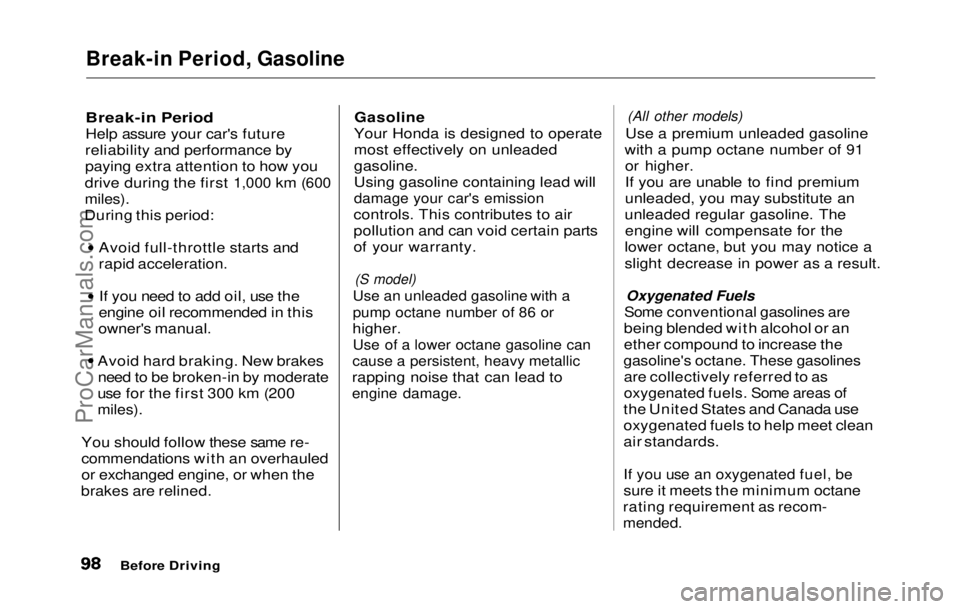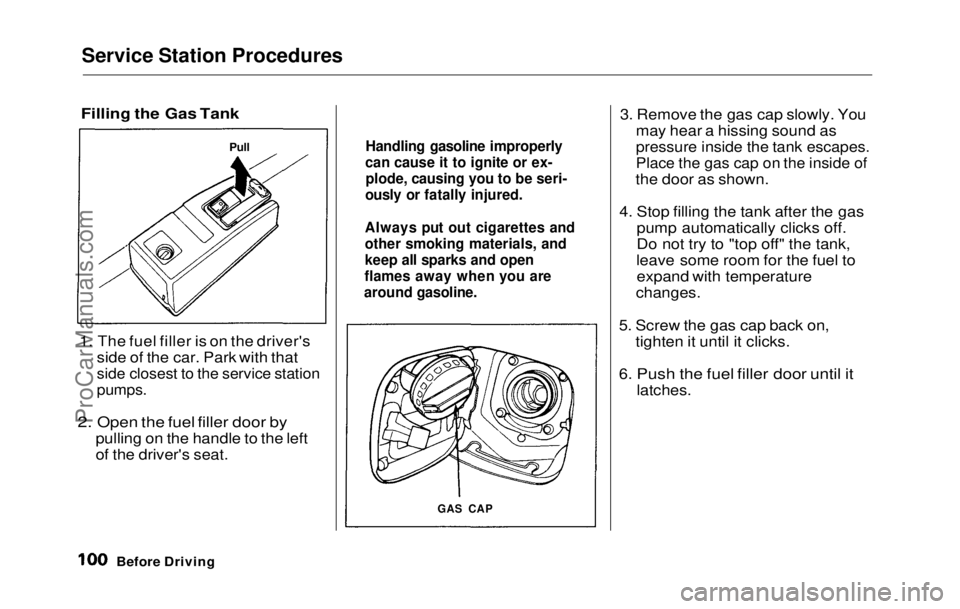fuel pump HONDA PRELUDE 1992 Owners Manual
[x] Cancel search | Manufacturer: HONDA, Model Year: 1992, Model line: PRELUDE, Model: HONDA PRELUDE 1992Pages: 225, PDF Size: 2.1 MB
Page 97 of 225

Break-in Period, Gasoline
Break-in Period
Help assure your car's future
reliability and performance by
paying extra attention to how you
drive during the first 1,000 km (600
miles).
During thi
s period:
Avoid full-throttle starts and
rapid acceleration.
If you need to add oil, use the
engine oil recommended in this
owner's manual.
Avoid hard braking. New brakes need to be broken-in by moderate
use for the first 300 km (200
miles).
You should follow these same re-
commendations with an overhauled
or exchanged engine, or when the
brakes are relined. Gasoline
Your Honda is designed to operate
most effectively on unleaded
gasoline.
Using gasoline containing lead will
damage your car's emission
controls. Thi s
contributes to air
pollution and can void certain parts
of your warranty.
(S model)
Use an unleaded gasoline with a
pump octane number of 86 or
higher.
Use of a lower octane gasoline can
cause a persistent, heavy metallic
rapping noise that can lead to
engine damage.
(All other models)
Use a
premium unleaded gasoline
with a pump octane number of
91
or higher .
I
f you are unable to find premium
unleaded, you may substitute an
unleaded regular gasoline. The engine will compensate for the
lower octane, but you may notice a
slight decrease in power as a result.
Oxygenated Fuels
Some conventional gasolines are
being blended with alcohol or an
ether compound to increase the
gasoline's octane. These gasolines
are collectively referred to as
oxygenated fuels. Some areas of
the United States and Canada use
oxygenated fuels to help meet clean
air standards.
If you use an oxygenated fuel, be
sure it meets the minimum octane
rating requirement as recom-
mended.
Before DrivingProCarManuals.comMain Menu Table of Contents s t
Page 98 of 225

Gasoline
ETHANOL (ethyl or grain alcohol) — Gasoline containing more than
10% ethanol by volume may cause
starting and/or performance
problems. Gasoline containing
ethanol may be marketed under the name "Gasohol."
METHANOL (methyl or woodalcohol) — Gasoline containing
methanol must contain cosolvents
and corrosion inhibitors to protect
the fuel system. Gasoline contain-
ing more than 5% methanol by
volume may cause starting and/orperformance problems and may
damage metal, rubber and plastic
parts o f
your fuel system.
MTBE (Methyl Tertiary Butyl
Ether) — You may use gasoline containing up to 15% MTBE by
volume.
Before using an oxygenated fuel,
try to confirm the fuel's contents.
Some states and provinces require
this information to be posted on the
pump. If you notice any undesirable
operating symptoms, switch to a
conventional unleaded gasoline.
Fuel system damage or perform-
ance problems resulting from the
use of an oxygenated fuel are not
the responsibility of Honda and are not covered under warranty.
Oxygenated fuels can damage paint and plastic. Be careful not to spill
fuel when filling your fuel tank.
Damage caused by spilled fuel is
not covered under warranty. Driving in Foreign Countries
Using any type of leaded gasoline
in your Honda will affect perform-
ance and damage its emission con-
trols. Unleaded gasoline may not be
available i
n
other countries. If you
are planning to take your car out-
side the U.S. or Canada, write to
Honda at the address shown for
information about any modifica-
tions your car may need. Be sure to include the year and model of your
car.
U.S. Owners:
American Honda Motor Co., Inc. Consumer Affairs
1919 Torrance Blvd.
Torrance, CA 90501-2746
Canadian Owners:
Honda Canada Inc.
715 Milner Ave.
Scarborough, Ontario M1B 2K8
Before Driving
NOTICEProCarManuals.comMain Menu Table of Contents s t
Page 99 of 225

Service Station Procedures
Filling the Gas Tank
1. The fuel filler is on the driver's
side of the car. Park with that
side closest to the service station
pumps.
2. Open the fuel filler door by
pulling on the handle to the left
of the driver's seat.
3. Remove
the gas cap slowly. You
may hear a hissing sound as
pressure inside the tank escapes.
Place the gas cap on the inside of
the door as shown.
4. Stop
filling the tank after the gas
pump automatically clicks off.
Do not try to "top off" the tank,
leave some room for the fuel to expand with temperature
changes.
5. Screw
the gas cap back on,
tighten it until it clicks.
6. Push the fuel filler door until it
latches.
Before Drivin
g
Handlin
g gasoline improperly
can cause it to ignite or ex- plode, causing you to be seri-
ously or fatally injured.
Always put out cigarettes and
other smoking materials, and
keep all sparks and open
flames away when you are
around gasoline.
GAS CAP
PullProCarManuals.comMain Menu Table of Contents s t
Page 187 of 225

If Your Engine Won't Start, Jump Starting
The Starter Operates
Normally
In this case, the starter motor
sounds normal when you turn the
ignition switch to START (III), but
the engine does not run. Are you using the proper starting
procedure? Refer to Starting
the Engine on page 109 . Do you have gas? Turn the
ignition switch to ON (II) for a
minute and watch the fuel gauge.
There may be an electrical
problem, such as no power to the
fuel pump. Check all the fuses
(see page 199 ).
If you find nothing wrong, you will
need a qualified technician to find
the problem. See Towing on page
202.
Jump Starting
If your car's battery has run down,
you may be able to start the engine
by using a booster battery. Although this seems like a simple
procedure, there are several precau-
tions you should take. Follow the
directions closely.
You cannot start a Honda with an
automatic transmision by pushingor pulling it. To jump start your car:
1. Open the hood and check the physical condition of the battery
(see page 152 ). In very cold
weather, check the condition of the electrolyte. If it seems slushy
or like ice, do not try jump
starting until it thaws.
If a battery sits in extreme cold, the
electrolyte inside can freeze.
Attempting to jump start with a frozen battery can cause it to
rupture or explode.
2. Turn off all the electrical acces- sories: heater, A/C, stereo system,
lights, etc. Put the transmission in Neutral
or Park and set the parking
brake.
Taking Care of the Unexpected
CONTINUED
A battery can explode if you
do not follow the correct
procedure, seriously injuring
anyone nearby.
Keep all sparks, open flames,
and smoking materials away
from the battery.
NOTICE
ProCarManuals.comMain Menu Table of Contents s t